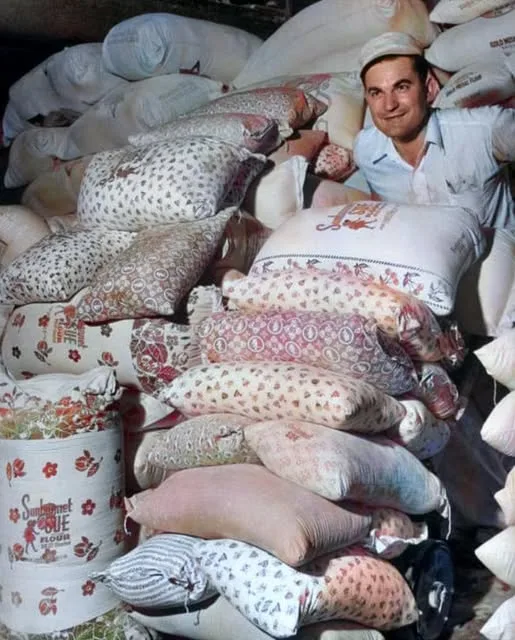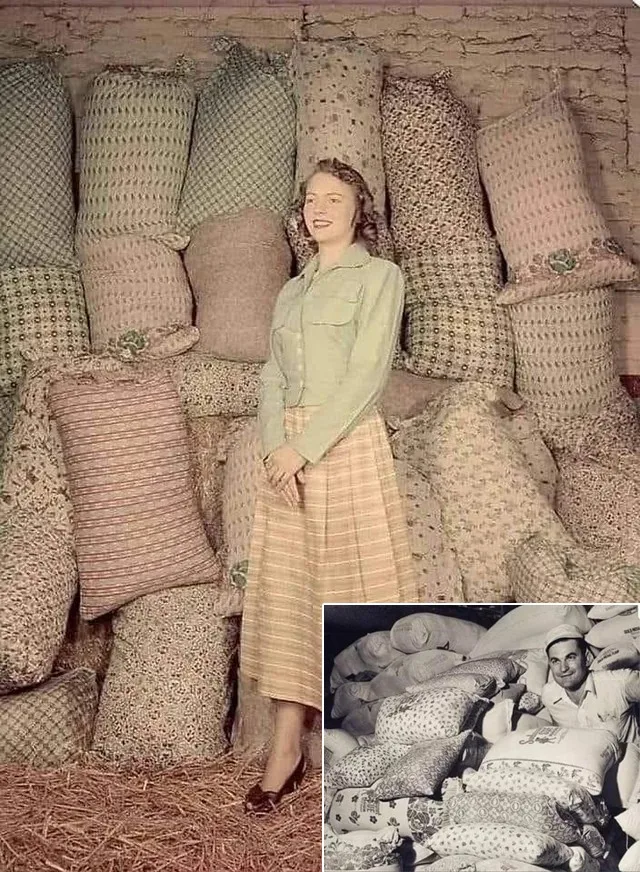You may have come across a viral photo of a smiling man surrounded by stacks of colorful flour sacks, with claims that these sacks were repurposed into clothing for children during tough times. Is it true? Absolutely! Flour sack clothing was a common practice from the 1920s to the 1960s, especially during times of economic hardship and war. Let’s explore the fascinating history of those floral flour sacks and their role in American ingenuity!

A Time of Resourcefulness
During the Great Depression and World War II, resourcefulness was essential. Families stretched every resource to make ends meet or support the war effort, and flour sack dresses became a practical and creative solution. Worn by women and children alike, these dresses have a unique history tied to recycling, resilience, and wartime frugality.
Cotton Sacks: From Flour to Fabric

In the 19th century, flour, sugar, and other goods were packaged in cotton sacks, replacing bulky wooden barrels. These sacks allowed mills to transport more product efficiently, reducing costs. Homemakers quickly saw potential in the excess fabric, transforming plain cotton sacks into dish towels, curtains, and other household items. By 1922, The Washington Post reported a shift to paper cartons, declaring the “farewell” of the cotton flour sack. However, as noted in Feed Sack Secrets: Fashion from Hard Times, a new chapter for flour sacks was about to begin, thanks to a man named Asa T. Bales.
From Flour Sacks to Fashion
In October 1924, Asa T. Bales from Roscoe, Missouri, patented the idea of printing cotton sacks with attractive patterns and sizing them for clothing. He assigned this patent to the George P. Plant Milling Co. in St. Louis for their “Gingham” flour line, which included brands like “Gingham Girl,” “Mother Gingham,” “Baby Gingham,” and “Gingham Queen.” The company saw this as a marketing opportunity, ensuring the sacks’ patterns were recognizable and the brand markings washable, making them ideal for sewing into clothes. Other mills followed suit, competing to create the most eye-catching designs, from soft pastels and florals to playful novelty prints featuring cartoon characters or seasonal themes.
Flour Sack Dresses in the War Era
By the 1930s and 1940s, the Great Depression and World War II had created fabric shortages, as cotton and wool were prioritized for military uniforms and supplies. Homemakers turned to flour sacks to craft clothing, and flour sack dresses became both practical and stylish. These dresses were everywhere, with women showcasing their sewing skills in competitions organized by local communities or even flour companies, who promoted their patterned sacks. The phrase “a yard saved was a yard gained toward victory” captured the spirit of the time, as families contributed to the war effort through resourceful recycling. Flour sack dresses weren’t just for women—children’s clothing, aprons, and even men’s shirts were crafted from the sturdy cotton fabric.
A Lasting Legacy
Flour sack dresses remained popular into the 1960s, when post-war prosperity and the availability of affordable ready-made clothing reduced the need for homemade garments. However, the legacy of flour sack clothing endures as a symbol of creativity and resilience. Today, vintage flour sack dresses are prized by collectors, and their story is celebrated in museums and historical exhibits. The viral photo of those beautifully printed sacks reminds us of a time when necessity sparked innovation, turning humble flour sacks into fashionable, functional clothing.


